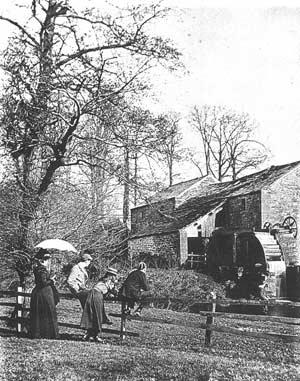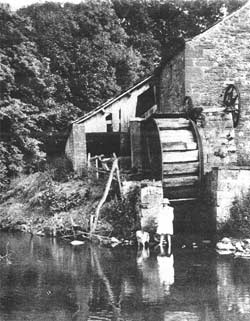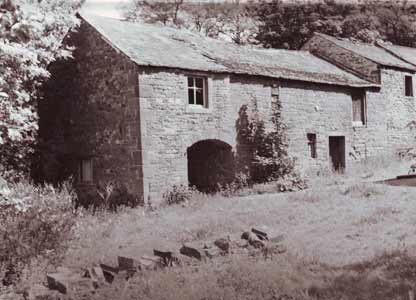Changing Uses for the Watermill
In 1873, Henry Boazman inherited Acorn Bank following the death of his mother, Mary. He moved back to the estate and rediscovered the presence of gypsum in 1880, last extracted from surface pits in the 1790s. This discovery was to impact the use of the mill some 30 years later.
A photograph of the mill dated around 1892 shows a 'new' waterwheel outside of the wheelhouse at the river end of the building. This was geared up to drive a sawmill, located in what's known as the cart house. It is thought that this was the second waterwheel repositioned. With cheap wheat flour now readily available in shops it is unlikely that milling of wheat would have continued it at Acorn Bank. Many water and windmills across the country closed in this period because they could not compete with industrial roller mills powered by steam and even electricity. Locally, demand for milled oats would have remained at least for animal feed if not for human consumption, so the 1st wheel and its double set of stones did continue to mill.
Acorn Bank is shown on the 3rd (1916) edition of the Ordnance Survey map as both a corn mill and a sawmill.
Anna Boazman inherited Acorn Bank in 1905 and clearly increased extraction of gypsum. A 6 inch to the mile OS map produced in 1920 shows not only the mill, but also gypsum quarries. By 1923 a drift mine was opened and the configuration of the mill changed yet again. The sawmill wheel had gone, with the waterwheel being returned to the wheelhouse and fitted onto a new, much stronger cast-iron shaft. This was required to drive a continuous rope pulley system that pulled loaded tubs of gypsum out from the mine nearly half-a-mile away. In 1925 the mine and the 2nd wheel were sold to the Gotham Company of Nottingham. The following year, an electric-powered aerial ropeway was installed, but local residents suggest that the waterwheel continued to be used by the mine until 1934.
At some time during the 1930s, milling stopped. The exact date is not known, however, the Boazman family sold the estate in part to Dorothy Una Radcliffe and her husband, Captain McGrigor Phillips during the early 1930s. By the 1940s, the mill was falling into disrepair.
In 1950, the National Trust acquired the estate and in 1984 the mill and surrounding buildings were given Grade 2 listed status. This lead the National Trust to restore the building in 1989 and open it to the public in 1995. In 2010, restoration of the top (1st) waterwheel and associated mill machinery was carried out by volunteers and this eventually lead to milling of flour in 2013. As a result of these works, Historic England upgraded the Mill's listed status to 2* in 2018.
Unfortunately, the Coronavirus pandemic lead to Acorn Bank shutting for an extended period starting March 2020. Due to the financial impact this has had on the National Trust, there was doubt whether the mill would be operated again. Consequently, the former National Trust mill volunteers have established a new charity, the Acorn Bank Watermill Trust to run and maintain the mill, which is being leased from the National Trust for a 5-year period.



